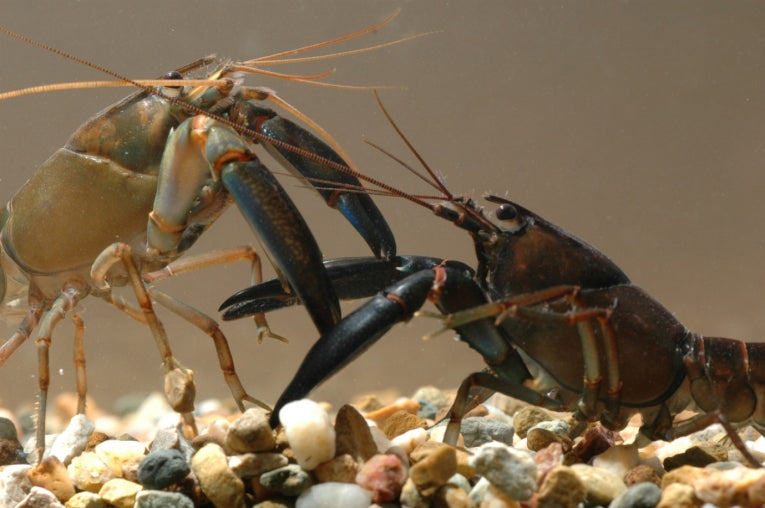The slender crayfish (Cherax dispar) is an Australian freshwater crustacean which loves to nip off your finger if you'll let it. Such useful aggression keeps it safe and in its territory where it battles all comers.
Robbie Wilson and Michael Angilietta Jr. of Arizona State University and the University of Queensland have used the behavioural repertoire of the species to illustrate an idea that isn't normally considered beyond the primates. Their full research paper has been published today in The Royal Society journal Biology Letters.
Your limbs and, in this case, the crucial big claws signal your aggression and can also function as the weapon of choice if you want to establish territory. The male signals great strength by waving his claws to demonstrate their size. Smaller males run away and all is well. But it's not. Often a big claw seems to have less musculature than a smaller one. This means that "little titch" could win the battle, but with selection for big claws, the claw signal has become "unreliable" and he never gets the chance to fight. Surprisingly, even female crayfish have more muscle per claw than large-clawed males. The ultimate disgrace would actually be losing to a female arm-wrestler like that!
Limb asymmetry and strength asymmetry are the terms used to describe the differential between a pair of claws' size and musculature. Left claws and right claws could be chosen for a signal, but one can be much bigger than the other. Here we have a cryptic (hidden) asymmetry that influences opponents to gain an unfair assessment of you.
North Stradbroke Island in Queensland was the source of 97 male adults whose chelae (claws) were measured and then their strength. This was achieved using sensors, reading results as a voltage convertible to the force applied between the chelae. The water temperatures used were both 14°C and 24°C. This ensured that the claw performed well within the normal range for the crayfish. Results showed that the relationship between size and strength was weak. There was a relationship between an individual's pair of claws, even if one was much larger/smaller.

Oh-oh! They're still at it, but looks like he's backing off - (The guy on the right seems to have a BIG claw); Credit: Anthony O'Toole
Unreliable signals in crayfish were demonstrable. When large variation in strength in similar chelae was confirmed, the "unreliable" signal must convey great benefit to a deceptive individual. To identify an opponent with an "unreliable" signal must cost a crayfish dear. If he makes a mistake, the loss of a claw and death must be some of the penalties regularly paid by a losing male.
Again, if the crayfish is recently moulted, then cryptic asymmetry would help out a sizeable proportion of the population. However, the ecology of this aggression ensures that one large chela might defeat a weaker opponent with two quite strong chelae (See the second photograph, where this is a possibility!) The benefits of this cryptic asymmetry could run deep, including an influence on natural selection. To be sure, the Australian mountains are full of crayfish species (such as the spiny crayfish). They could have speciated a long time ago, gifting us some valuable genetic data. We certainly go in for faking ourselves and other creatures could be "faking it" throughout the animal kingdom. What a thought.










